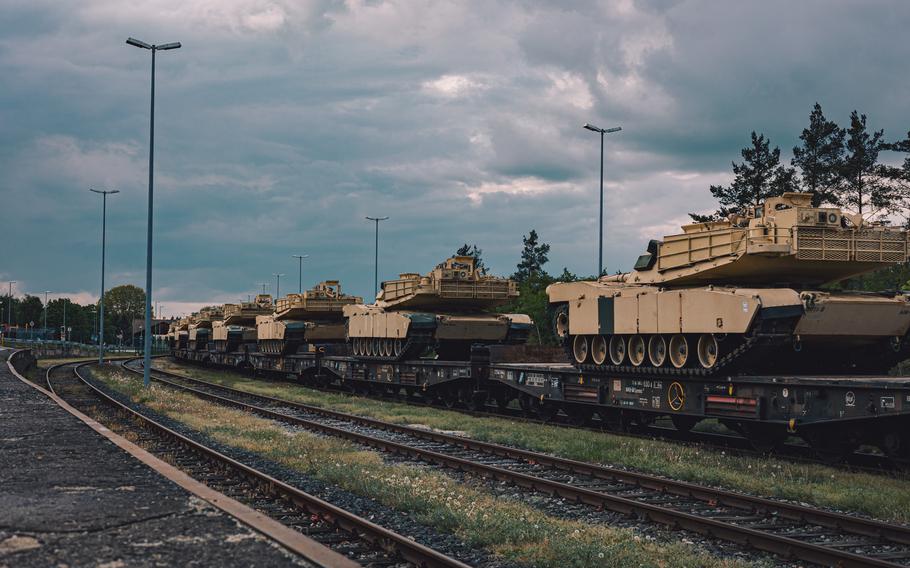
M1A1 Abrams tanks needed for training the armed forces of Ukraine arrive by rail at Grafenwoehr, Germany, May 14, 2023. (Christian Carrillo/U.S. Army)
WASHINGTON — The first shipment of Abrams tanks has arrived in Ukraine — eight months after the Pentagon ordered them and much sooner than officials expected they would be delivered.
The Defense Department in January committed almost three dozen M1 Abrams tanks to help Ukraine fight off invading Russian forces.
“It is the first tranche of Abrams that has arrived,” Pentagon spokeswoman Sabrina Singh said Monday. “But in terms of numbers or movements on the battlefield, anything like that I’d let the Ukrainians speak to that.”
Pentagon officials did not specify how many were delivered but promised in January that Ukraine would receive 31 Abrams tanks.
“The Abrams is already in Ukraine and is preparing to strengthen our brigades,” Ukrainian President Volodymyr Zelenskyy said in a post to the messaging app Telegram. “I am grateful to the allies for fulfilling the agreements.”
The tanks are expected to be used in Ukraine’s ongoing counteroffensive against Russian forces in the south and far east of the country.
“Every week adds to Ukraine’s strength and capabilities. Hence, every week brings our victory closer,” Zelenskyy said.
Pentagon officials originally said it would probably be 2024 before Ukraine saw the first tanks arrive, but they sped up the process in March by choosing to refurbish older M1A1 versions of the tank instead of the newer M1A2 it originally planned to send. Because the Army already had M1A1s available for the project, the Pentagon opted to refurbish and send those instead. The move shaved several months off the arrival of the tanks.
“This is about getting this important combat capability into the hands of Ukrainians sooner rather than later,” Air Force Brig. Gen. Pat Ryder, the Pentagon’s top spokesman, said at the time.
Ukraine had been asking for the Abrams tanks for weeks by the time the White House agreed to send them. The U.S. had previously resisted giving Abrams tanks to the Ukrainians because U.S. officials said the tanks were not well-suited for Ukraine, largely due to the weapon’s complexity and need for regular maintenance in the field. The tanks also primarily run on jet fuel, which was another consideration, officials said.
When the White House chose to send the M1A2 version of the tank, it was decided to build them through the Ukraine Security Assistance Initiative — a program that procures weapons and equipment from the defense industry rather than pulling them from Defense Department stocks. But by using the initiative, the equipment takes months longer to reach Ukraine.
The first model of the Abrams tank entered service in 1980 and the M1A1 followed in 1985. The newest variant, the M1A2, has been in service since 1992 and is the version that has the most sophisticated features. For example, it’s equipped with an independent thermal sight and can fire at two different targets virtually at the same time without having to lock on sequentially. It also has an automatic firefighting system in the crew compartment and can deflect computerized inbound missiles. Some of the later variants have a series of refinements that allow the tank to perform better in urban warfighting environments.
It’s not known how the M1A1s for the Ukrainians are equipped. U.S. military equipment manufactured and sold to foreign allies often has different features, especially when it comes to classified hardware packages such as depleted uranium armor.
The Abrams tank typically carries a crew of four and its main armaments are usually 105 mm or 120 mm shells, along with a .50 caliber machine gun. Its maximum speed is between 42 mph and 45 mph on roads and 25 mph to 30 mph off roads. The Army is now the only service branch that uses the M1 Abrams, though the Marine Corps did use the tank at one time.
Earlier this year, Ukrainian officials had said they needed dozens of sophisticated Western-made tanks to fight Russian forces. When the U.S. agreed to send the Abrams, Germany also said it would supply Ukraine with some Leopard tanks, and Britain contributed more than a dozen of its Challenger tanks.
The Abrams tanks’ arrival came just days before a potential U.S. government shutdown that could have an impact on Ukraine’s war against Russia. Defense Secretary Lloyd Austin has exempted U.S.-led training — such as F-16 training for Ukrainian pilots set to begin in Arizona next month — and other operations related to Ukraine from being affected by a shutdown. The Pentagon said Monday, however, the shutdown could affect Ukraine in a more indirect way.
“We are trying to keep equipment and supplies flowing, but absolutely things could be delayed,” Singh said. “If any of our personnel are furloughed, yes that could have impacts to the larger mission.”
A small group of hard-line Republicans in the House are threatening to oppose new funding for the government after fiscal 2023 ends Sept. 30 over issues such as money for a wall along the U.S.-Mexico border and aid to Ukraine in fiscal 2024. U.S. troops and some civilian defense workers would keep working during a shutdown, but they might not be paid on schedule.
The Pentagon has committed nearly $45 billion in military aid to Ukraine since the country was invaded by Russian forces in February 2022. New weapons shipments to Ukraine wouldn’t stop during a shutdown since they were exempted by Austin.